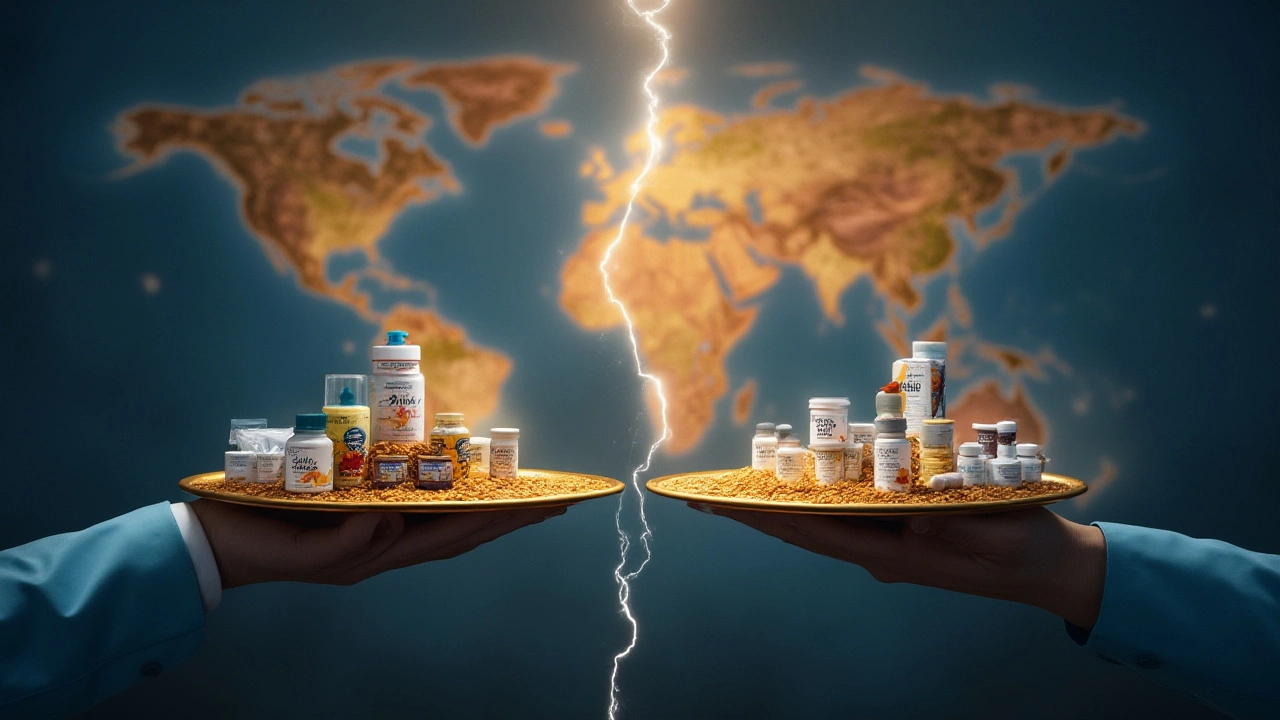Picture this: you’re walking into a pharmacy or scrolling through health news, and the names Abbott and AbbVie keep popping up. Both are titans in healthcare, but which one is truly bigger? This isn’t just a who-has-the-most-money debate—it's a story of surprising spin-offs, blockbuster drugs, and two very different ideas of what success looks like in the pharma world.
The Backstory of Abbott and AbbVie
Abbott’s story starts way back in the 19th century—1888 to be precise—when a Chicago physician, Wallace Calvin Abbott, concocted tiny medicinal powders for his patients. Fast forward over a century, Abbott’s become a global health behemoth, making everything from diagnostics and nutrition products to heart devices. But then comes the twist: in 2013, Abbott spun off AbbVie, its research-based pharmaceutical arm. So, these companies are like siblings with different personalities—Abbott sticks with nutrition, medical devices, and diagnostics, while AbbVie takes care of advanced prescription drugs.
If you look at Abbott’s product parade, you’ll spot Ensure shakes, FreeStyle glucose monitors, and widely used COVID-19 tests that became household names during the pandemic. AbbVie, on the other hand, banks on prescription meds you’ve definitely heard of—most famously, Humira, which has been among the world’s top-selling drugs for years. The 2013 spinoff let each company focus hard on its own thing, making them both sharper and arguably stronger players in their lanes.
This separation ended up being a major industry shakeup. Abbott, now focused on tools and nutrition, started innovating in diabetes care (think Libre glucose sensors). Meanwhile, AbbVie poured its energy into hunting for drug breakthroughs, not just for arthritis or Crohn’s, but seriously tough stuff like cancer and neurological diseases. If you're tallying up influence or money, it's wild to see how this split didn’t weaken either brand—instead, it pushed each to become even more monstrous in their own right.
Here's a weird but true fact: ever since their split, the two have frequently leapfrogged each other in the rankings of Fortune 500 giants and global pharma powerhouses. It's like a stealthy rivalry that most pharmacy shoppers never even realize is going on.
Crunching the Numbers: Revenue, Market Cap, and Workforce
Alright, let’s talk size by the numbers, because nothing spells 'big' quite like revenue and market value. Looking at revenues for 2024, Abbott pulled in about $43.6 billion, while AbbVie topped that with a whopping $54.3 billion. On paper, AbbVie is the bigger earner and that’s almost entirely thanks to its drug pipeline—Humira, Skyrizi, Rinvoq, and Imbruvica have become pharma household names. It's all about blockbuster drugs, and AbbVie’s knack for finding or developing them.
Market capitalization—the total value of a company’s shares—tells a slightly different story. Both companies trade on the New York Stock Exchange. Abbott’s market cap as of July 2025 hovers around $180 billion, while AbbVie is close, at about $175 billion. Their values see-saw depending on drug launches and earnings reports, but there's no denying both float in the top 10 of global pharma giants.
Employees? Abbott takes the edge here, boasting over 115,000 employees worldwide as of 2024, compared to AbbVie’s roughly 50,000. Abbott’s bigger workforce makes sense—they manufacture physical products and devices for hospitals and clinics all over the world, so more hands on deck are needed beyond just research and sales.
| Company | 2024 Revenue | Market Cap (July 2025) | Employees |
|---|---|---|---|
| Abbott | $43.6B | $180B | 115,000 |
| AbbVie | $54.3B | $175B | 50,000 |
But don’t be fooled—size isn’t just about cash flow or headcount. Influence in healthcare means whose products are used most, where, and for what. Abbott tests, monitors, and nutritional shakes touch millions of lives daily. But a single blockbuster drug at AbbVie can change or save a life too, sometimes in conditions that seem untreatable.
So, who’s bigger? It’s kind of a toss-up, right? AbbVie’s revenue edges higher thanks to mega drugs, but Abbott gets the workforce and asset spread trophy.

Market Impact and Global Reach
Here’s where things get spicy. Abbott is a true global citizen, with products circulating in 160+ countries. Think baby formula for new parents in India, or blood testing equipment in half of Nigeria’s hospitals. During the COVID-19 pandemic, Abbott’s rapid test kits became one of the default solutions for travelers and hospitals worldwide, shipping millions of units almost overnight.
The company is especially dominant in point-of-care diagnostics (those fast tests you get at clinics) and diabetes management, especially through its FreeStyle Libre sensor line. Abbott’s FreeStyle Libre sales jumped over 35% last year, signaling how much they’ve cornered the market in glucose monitoring convenience. Meanwhile, their nutrition business is rock solid—yes, they still sell more Ensure shakes and Pedialyte pouches every year than you’d imagine.
AbbVie’s global reach, meanwhile, is all about its medicines. Humira’s been approved in 60+ nations and it alone has grossed over $200 billion globally since launch—a record for prescription drugs. With newer immunology drugs like Skyrizi and Rinvoq gaining traction, AbbVie’s market impact is tilting more and more toward chronic illness, autoimmune conditions, and specialty cancer treatments (following the $63 billion purchase of Allergan in 2020, which brought blockbuster Botox into the fold). So while you may not see AbbVie’s name plastered in supermarkets like Abbott, it’s a silent juggernaut inside hospital oncology wards and rheumatology clinics worldwide.
According to industry analyst Eva Lee at Evercore ISI:
“AbbVie’s ability to repeatedly deliver best-sellers in the most competitive pharma segments shows just how strong its R&D engine has become. They rarely miss on blockbuster potential.”That’s a reputation anyone in big pharma would kill for.
Different kinds of global impact, but both are everywhere—just in very different ways.
Products, Patents, and What's Coming Next
The story of the Abbott-AbbVie rivalry is also the story of product innovation. Abbott keeps churning out new versions of existing devices, from easy-stick heart monitors to ever-improving virus testing. The company’s approach is all about making everyday health management more doable—you see it in better glucose sensors or easier ways to check kidney function at home. Their R&D spending hit $2.8 billion in 2024, funneling cash into the next-gen diagnostic tech and nutritional products.
AbbVie’s innovation is almost laser-focused on drugs. After Humira’s U.S. patent cliff (when cheaper copies, known as biosimilars, hit the market), AbbVie scrambled to extend its pipeline—and so far, it’s working. Drugs like Rinvoq (autoimmune diseases) and Skyrizi (psoriasis, Crohn’s, more) are rapidly taking Humira’s place at the top of the sales charts. Add in the huge Allergan buyout (hello, Botox and aesthetics!), and suddenly AbbVie owns a big chunk of both treatment and self-care categories.
When it comes to patents, it's a game of chess for AbbVie. At one point, they had dozens of legal challenges defending Humira’s secrets. It's worked so well that the medicine bankrolled their drug development for a decade. Abbott, less exposed to patent drama, rides on steady demand for its consumer and diagnostic products.
Looking forward, both companies are racing ahead. Abbott’s investing huge in AI-powered diagnostics and remote health tracking. Imagine getting more medical help at home or via your phone. AbbVie, meanwhile, has a big bet on neuroscience—hunting for new treatments in conditions like Alzheimer’s, migraine, and even depression. And both have a steady pipeline of new launches set for the next three years.
For investors or curious health nerds, this all means the Abbott/AbbVie race is set to continue, likely with more crossovers, mergers, or surprise breakthroughs ahead.

Who Gets the Crown for 'Biggest'? (And Why It Matters)
So, who’s bigger—Abbott or AbbVie? It’s not as easy as looking at a single number. AbbVie edges out in annual revenue, but Abbott wins in employee count and product variety. AbbVie’s most famous product, Humira, is a moneymaker few can match, but Abbott’s stable business model from testing to nutrition makes them a safety-first pick for investors. Each company is a heavyweight in their own lane.
Why does this matter? If you’re a hospital admin, your Abbott contracts decide how quickly you get test results or keep diabetes patients stable. If you’re a patient with rheumatoid arthritis or Crohn’s, AbbVie might have changed your life. For investors, knowing who’s more dominant can mean big market decisions—AbbVie gives you blockbuster risk (and reward), Abbott offers steady hands and global reach.
Here’s the big tip: don’t just look for the largest ‘number’ or the most employees. Think about which company’s products will keep adapting best to new diseases, aging populations, and ever-rising health expectations. Watch for new launches, major mergers, and—crucially—the next wave of biosimilars and device innovations, which can shake up rankings in a heartbeat.
Abbott or AbbVie? In the world of healthcare, there’s plenty of room at the top for both. But the real winners might just be all of us, as competition pushes both giants to innovate, improve, and fight for our health in ways we didn’t see coming a decade ago.
